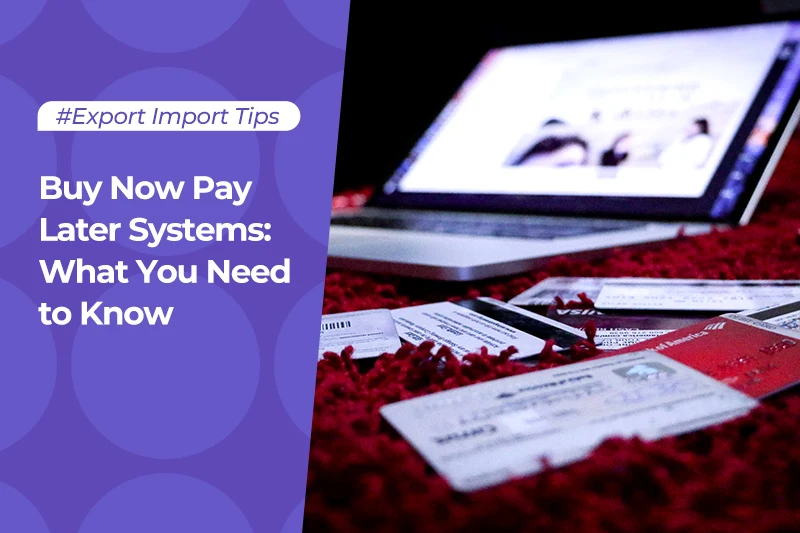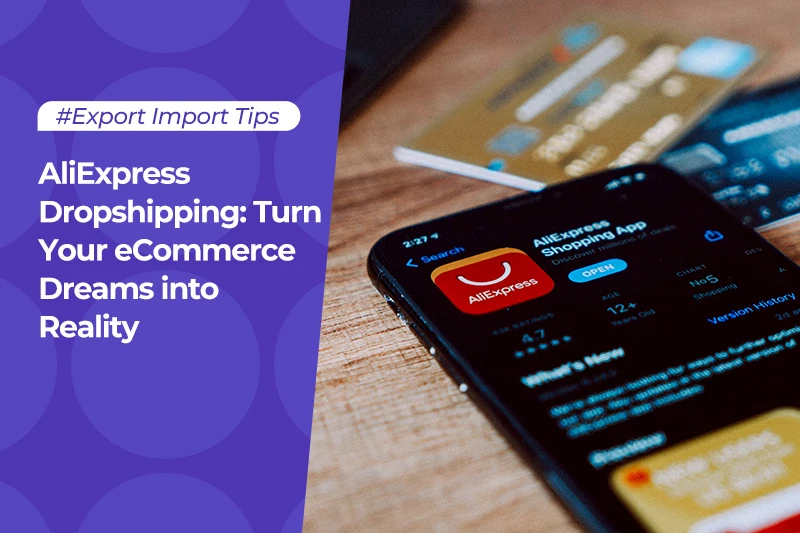7 digital export trends for 2023

It’s that time of the year again. As 2022 winds down and B2B companies lay plans for the new year, we’re looking at the key digital export trends that will shape global trade in 2023.
This year, companies worldwide experienced various trade shocks, ranging from global conflict to volatile energy prices and soaring inflation. Thankfully, the ability to digitally reach customers locally and globally without stretching operating budgets helped provide an important buffer.
But how will digital selling change in 2023? What can B2B sellers expect from the competition? By how much will buyer expectations change in the coming year? Here’s a rundown of the key digital export trends to look out for in 2023.
Table of Contents
What is digital export?
As the name suggests, digital export means engaging in international export trade using digital selling channels. It typically involves using internet resources like social media, search engines, e-commerce stores, and online marketplaces to reach foreign buyers.
Unlike traditional export methods that leverage physical selling channels like international conferences, trade expos, or local trade contacts in foreign countries, digital export has several advantages. Because it happens through electronic platforms, it reduces the expense and logistical challenge of traditional exports.
For instance, you can meet thousands of buyers on a B2B marketplace like Alibaba.com without needing to source contacts individually. In addition, digital export through such a marketplace also offers logistical advantages as it provides a single platform where you can coordinate marketing, negotiations, sales, and delivery.
Consequently, if you’re new to online selling, it’s worth exploring what digital exports can do for your business. As you’ll see in the next section, digital trade has been a lifesaver for many companies over the past three years.

Global trade and economy in the post-pandemic era
At the onset of the pandemic in 2020, astute experts predicted that the COVID-19 disruption would be the most significant event of this decade. Three years later, this position is proving prophetic, particularly concerning the e-commerce industry.
2020 brought about an explosion in B2B e-commerce, with more micro, small and medium enterprises (MSMEs) than ever moving to digital selling. While global trade suffered, digital exports of consumer goods rose by 14%, compared with 2019.1 But the effects of the pandemic didn’t remain in just 2020.
In 2021, pandemic-related headwinds caused significant shocks to the global economy. A sharp rise in consumer demand, fueled by the lifting of lockdown mandates and stimulus checks, led to an uptick in economic activity for the year. But the surging demand also caused extensive supply backlogs as producers struggled to reclaim supply chains from the COVID-induced disruptions of 2020.
As a result, the defining picture of the year for global trade would be clogged ports filled with ships unable to pick up or drop off overdue cargo, record-high shipping costs, and increased energy prices. Despite these roadblocks, international trade continued to enjoy a resurgence, posting a record world trade value of $5.6 trillion by Q3 2021.2 During the same period, e-commerce sales grew by 11%, continuing the impressive trend set in 2020.3
2022 has yet to maintain the trade gains of the previous year, however. While global think tanks like the World Bank had predicted slower global economic and trade growth in 2022, other factors conspired to make actual performance for the year worse. Multi-year high inflation levels, the damaging Russia-Ukraine war, continuing COVID-19 outbreaks in Asia, and a spate of global interest rate hikes all contributed to worse trade performance during the year.
According to the World Trade Organization (WTO), world trade will lose momentum this year due to these shocks. While global merchandise trade volumes are expected to grow by 3.5% in 2022, those figures will likely fall significantly to 1% in 2023.4 Inflation is still a concern, with energy prices up 78% compared to last year and food prices up by 11%, and there is no slowdown currently in sight.4
The OECD reports similarly conservative figures, putting expected global economic growth at just 2.2%, compared to the earlier projected 3.2%.5 These projections likely mean small companies faced with difficult conditions this year might not get a respite in 2023.
Consequently, it makes sense for concerned sellers to pursue means to manage their risk and reduce exposure to the effects of an increasingly uncertain global economy. Digitalization and a shift to online selling can help cushion these effects and potentially provide a platform for growth.
Importance of digital transformation for MSMEs
Digital transformation is the deliberate effort to improve a company’s operations using digital tools. It’s a modern operational mindset that looks for ways to achieve efficiency and productivity gains through digital technologies.
As the OECD suggests, even though digital transformation is crucial for MSMEs, these companies often need to be more digital. For instance, research indicates that, in many countries, less than 40% of employees in small firms use connected computers.6 Even fewer companies adopt digital solutions such as enterprise resource platforms and e-commerce stores in their day-to-day work.
However, companies that adopt digital transformation in their operations can unlock several potential benefits, including possibilities to:
- Reduce business risk: Many companies face dramatically increased risk due to today’s business environment. For instance, operational risk from an inability to find customers and dispose of inventory was a threat for many MSMEs during the pandemic. Going digital helped many companies combat this risk, as they could access selling opportunities while their physical locations were closed.
- Reach more customers: Clearly, digital export presents far more opportunities to find, connect with, and convert more buyers. With the nearly unlimited possibilities of digital trade, small companies have few limitations to the range and quality of prospects they can access. And when they combine this advantage with great marketing on a helpful platform, they can find more high-quality leads that ultimately convert into a sale.
- Improve productivity and manage costs: Small companies that implement digital transformation can reduce costs and boost productivity by 16% on average.7 You can save time on low-value labor and reinvest that time in quality interactions that grow your business. Likewise, companies with digital selling channels ultimately spend less on acquiring new clients and can expand internationally at little cost.
- Boost company profits: Digital transformation also helps unlock greater profits and trade presence. For instance, one study found that 85% of companies implementing digital processes acquired greater market share.8 They were also able to increase company value by 25%.7
- Ensure business certainty: Ultimately, it’s important to recognize that choosing to go digital is choosing certainty in an unpredictable business world. Amidst supply and demand chain shocks, enduring viral outbreaks, and an unstable geopolitical landscape, the reality for small businesses is that every advantage counts. If that advantage consists in having a reliable way to sell through supply and demand shocks, then it’s worth taking a closer look at.
7 digital export trends for 2023
The coming year will see some enduring trends continue, like the rise of personalization and video marketing in B2B e-commerce. But some new trends will take center stage, such as a fall in the time consumers spend online.
Being up to date on these trends, and understanding their underlying data, will be crucial to business success in 2023. Let’s dive in.
1. Digital migration
We’ve discussed how more companies have transitioned to digital selling since 2020. This trend is set to continue in 2023. According to data from the OECD, 70% of small companies surveyed said the impact of COVID-19 drove them to make greater investments in digital technologies.6
With the enduring shocks of the pandemic, more businesses will go digital. The relative certainty of digital selling will be just what many companies need to keep operations ticking over in the coming year.
One implication of this trend is that B2B online sellers will likely see greater competition next year. If your competitors aren’t already online, the odds are that they will get online in 2023. Consequently, if your business is not yet digital, you should plan to transition by next year.
2. Digital marketing and administration
More small companies will find their way online in 2023. But many of the newcomers will look to make a gradual entry into the digital selling space. The OECD suggests that new digital market entrants will prioritize electronic marketing and administrative functions.
Digital marketing is already a big draw for companies, especially considering that 93% of all interactions on the internet happen through search engines.9 With digital marketing, new entrants can immediately start working to gain a share of those interactions.
There’s also likely to be a rise in companies using digital tools for administrative purposes. For example, popular products like Notion, Evernote, and Canva are options businesses can employ for organizing and clerical tasks.
3. Data-led marketing
Marketing is increasingly a precise exercise focused on targeting specific prospects. We’re now well beyond the days of B2B marketing strategies hinged on guesswork. With data-led marketing, businesses are introducing greater accuracy to their marketing. As a result, they can yield better results and gain more insights from previously opaque data sets.
Part of this capability arises from better tools that let companies access and exploit broader data types. There’s a greater variety of data that enables companies to plan, test, and launch successful marketing campaigns. Companies can also apply better data to assess and learn from marketing campaigns.
4. Personalization
Personalization across various business touchpoints continues to be a key trend for digital exports. Customers don’t want to feel like just one of the thousands – they want to feel seen and heard.
How do you implement personalization in your business practices? Start by incorporating personal details in communications with the client. For example, are you sending cold emails? Simply addressing the customer by their name can help. You can also research the client’s unique needs and incorporate that into your proposition.
Other ways customers seek personalization include how they are offered services and products. For instance, a customer who bought from you expects you to know their previous purchases and leverage that information during a repeat purchase.

5. Time spent online
People typically spend between six and seven hours on the internet. According to statistics, the average person spends roughly 40% of their waking life accessing an internet-enabled device or service.
But those statistics have fallen recently. Average time spent online fell to 6.47 hours from 6.53 hours in Q4 2021.10 While this drop isn’t significant, it is an indicator of a likely peak in the overall time that people spend using the internet.
As a result, offering digital content to users may become trickier for businesses. There’s now a greater need to ensure they’re providing enduring value. Otherwise, they may find users leaving their content for other digital consumables.
6. Video marketing
Video is a compelling medium due to its ability to engage by showing. So, it’s unsurprising that video marketing continues to gain ground in digital export. Platforms like Alibaba.com incorporate video into their marketing channels to help foster greater engagement with buyers.
While short-form videos are currently the most popular, there is scope for growth in the consumption of long-form and live-streamed videos. Most important is ensuring that prospects see images that align with their buying intentions.
7. Real-time messaging
Finally, along with growing buyer preference for rapid service, real-time messaging is emerging as a key trend for B2B digital exports. Buyers don’t want to wait hours or days to receive responses from B2B sellers.
Consequently, sellers are implementing methods to ensure real-time or near-real-time buyer engagement. These include the use of chatbots incorporated into their e-commerce store. For sellers with a presence on B2B marketplaces, one option is to employ mobile applications they can access on the go.
Sell on Alibaba.com
When it comes to digital exports, Alibaba.com is the world’s leading B2B marketplace connecting millions of buyers with sellers. The platform offers a wide collection of tools that facilitate international digital trade, from customizable storefronts and assistive product posting to intelligent marketing tools.
See what the platform is all about – open a seller account today.
References
1. https://www.morningfuture.com/en/2021/05/26/export-e-commerce-pandemic/
2. https://unctad.org/news/global-trade-goods-hits-all-time-quarterly-high-56-trillion
3. https://www.salesforce.com/resources/research-reports/shopping-index/
4. https://www.wto.org/english/news_e/pres22_e/pr909_e.htm
5. https://www.oecd.org/economic-outlook/september-2022/
6. https://www.oecd.org/industry/smes/PH-SME-Digitalisation-final.pdf
7. https://www.mti.gov.sg/-/media/MTI/Resources/Economic-Survey-of-Singapore/2019/Economic-Survey-of-Singapore-First-Quarter-2019/FA2_1Q19.pdf
8. https://www.sap.com/dmc/exp/4-ways-leaders-set-themselves-apart/index.html
9. https://www.imforza.com/blog/8-seo-stats-that-are-hard-to-ignore/
10. https://datareportal.com/reports/looking-ahead-to-what-2023-holds
Start your borderless business here
Tell us about your business and stay connected.
Keep up with the latest from Alibaba.com?
Subscribe to us, get free e-commerce tips, inspiration, and resources delivered directly to your inbox.















